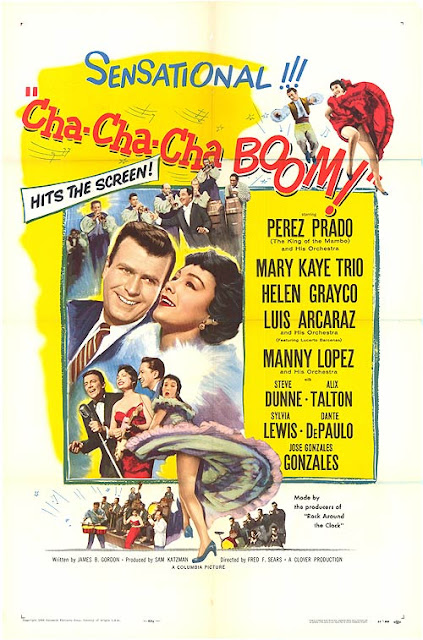We've all faced challenges lately, which makes me all the more grateful for this year's blessings. After exactly two decades, I had the opportunity to reconnect with and present the awe-inspiring 20-member Mambo Legends Orchestra (essentially, the former Tito Puente Orchestra) in a concert glowingly-reviewed by The Huffington Post. That same day, I welcomed the amazing Joe Conzo - Tito Puente's biographer, archivist and best-friend of over 40 years - as my guest panelist for the season three-finale of 'Metro Mambo' - my Latin-jazz lecture series for the Smithsonian Institution.
As a result of that collaboration, Joe agreed to become a regular guest on my radio show for a segment called the 'Metro Mambo Time Machine'. To my delight and astonishment, Joe has generously agreed to share gems from his renowned private collection of ultra-rare vintage recordings by everyone from Tito Puente and Machito, to Orquesta Broadway and Arsenio Rodriguez. Rarest of all are reel-to-reel recordings made live in the 1950's, 60's and 70's at venues such as the Apollo, the Band Box, The Beacon Theatre, Birdland, and the Palladium Ballroom - New York's fabled 'Home of the Mambo'.
The segment debut was on October 28, in tandem with the release of his latest endeavor, as executive producer for Sony Music Latin's boxed-set "Quatro: The Definitive Collection" - a beautifully presented re-mastering of four classic Tito Puente albums of the mid-1950's through early 1960's - appropriately displayed above on the 1961 Webcor Overture Silhouette Stereo console (...and the word 'albums' is correct, as it has been released both on CD and in real, high-quality vinyl). In addition to writing the liner notes, Joe provided the content for a fifth 'bonus album' featuring multiple out-takes from the recording session for Pa' Los Rumberos from Puente's classic 1956 album "Cuban Carnival."
These out-takes and live recordings are a critical reminder of the virtually lost craft of 'live' recording. Today, musicians often record their respective segments individually, only committing the perfect track to the completed whole. Sometimes, the musicians can be hundreds, if not thousands of miles apart from one another. How refreshing to hear the misfires, flubs, and even Puente's exasperation - reminding us not only of the hard work involved, but also of the bonding between 15, 18 or 20 individual artists as they struggle collectively to create the gift of something truly fine.
That level of quality contains another rare ingredient: time. Before hearing the familiar studio recording of Mambo Gozon from Puente's landmark 1958 album "Dance Mania,"we played Joe's un-released live recording of the tune - from two years earlier(!) It's a little slower, sans vocals - but with the addition of instrumental jazz solos(!). All of our favorite vamps and breaks are in evidence, but differently ordered or inverted. Recorded at El Patio Club on Atlantic Beach on Long Island, New York, Joe confirms it as the club at which, Joe confirms, Puente first performed with his own band in 1949 (sharing the bill with a young Tony Bennett). But it confirms that Puente didn't just write a tune and run into he studio. Actually, he'd been work shopping Mambo Gozon for two years - polishing it to a deep, rich lustre - before taking it into the RCA-Victor studio's for the then highly-expensive recording process.
At times, hundreds of dancers would just stand in awe, transfixed as the Mambo Legends Orchestra performed a range of new works and Palladium-era classics at Artisphere in Arlington, Virginia back in September. These vintage recordings underscore why. The Band is a direct link to a bygone era of artisanal music, crafted live by musicians committing actual skin, breath, blood and bone to its creation. Without any computerized tricks, the presentation is so perfect as to be almost otherworldly. Just as on Puente's classic albums like "Dance Mania" and "Night Beat," the MLO sounds almost like an Organ - as if the musicians were being manipulated in-unison by one instrumentalist 'playing them' via a keyboard. Watch and listen....
Hearing the Puente out-takes from "Quatro" - and Joe Conzo's early live recordings allowing us to hear the classics of Latin-jazz literally being born - reminds us not only of the majesty of 'El Rey', but also of the meaning of true artistry. The synthesised 'perfection' achieved today through computer chips will always sound hollow. Disconnected. Nothing can compare the sound of artists who take you with them in their passionate pursuit of that perfection - and getting close enough to connect us to the Divine.
P.S.: So where in the heck has Mambo-phoniC been? Ahhhh..., the best laid plans of mice and men - and mambo. How diligent I was going to be, I said back in the Spring, about keeping up with Mambo-phoniC! Well.., one job restructuring, a major car accident, three consecutive surprise interim assignments, a derecho storm, and two home mortgage refinancing's later, and well... I'm still here, and so are you. And we're blessed to be here. So..., here is the next monthly installment of Mambo-phoniC!



